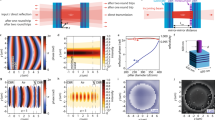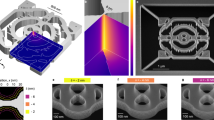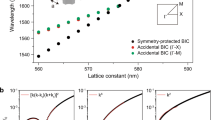Abstract
Photonic cavities that strongly confine light are finding applications in many areas of physics and engineering, including coherent electron–photon interactions1, ultra-small filters2,3, low-threshold lasers4, photonic chips5, nonlinear optics6 and quantum information processing7. Critical for these applications is the realization of a cavity with both high quality factor, Q, and small modal volume, V. The ratio Q/V determines the strength of the various cavity interactions, and an ultra-small cavity enables large-scale integration and single-mode operation for a broad range of wavelengths. However, a high-Q cavity of optical wavelength size is difficult to fabricate, as radiation loss increases in inverse proportion to cavity size. With the exception of a few recent theoretical studies8,9,10, definitive theories and experiments for creating high-Q nanocavities have not been extensively investigated. Here we use a silicon-based two-dimensional photonic-crystal slab to fabricate a nanocavity with Q = 45,000 and V = 7.0 × 10-14 cm3; the value of Q/V is 10–100 times larger than in previous studies4,11,12,13,14. Underlying this development is the realization that light should be confined gently in order to be confined strongly. Integration with other photonic elements is straightforward, and a large free spectral range of 100 nm has been demonstrated.
This is a preview of subscription content, access via your institution
Access options
Subscribe to this journal
Receive 51 print issues and online access
$199.00 per year
only $3.90 per issue
Buy this article
- Purchase on Springer Link
- Instant access to full article PDF
Prices may be subject to local taxes which are calculated during checkout




Similar content being viewed by others
References
Khitrova, G., Gibbs, H. M., Jahnke, F., Kira, M. & Koch, S. W. Nonlinear optics of normal-mode-coupling semiconductor microcavities. Rev. Mod. Phys. 71, 1591–1639 (1999)
Noda, S., Chutinan, A. & Imada, M. Trapping and emission of photons by a single defect in a photonic bandgap structure. Nature 407, 608–610 (2000)
Song, B. S., Noda, S. & Asano, T. Photonic devices based on in-plane hetero photonic crystals. Science 300, 1537 (2003)
Painter, O. et al. Two-dimensional photonic band-gap defect mode laser. Science 284, 1819–1821 (1999)
Noda, S., Tomoda, K., Yamamoto, N. & Chutinan, A. Full three-dimensional photonic bandgap crystals at near-infrared wavelengths. Science 289, 604–606 (2000)
Spillane, S. M., Kippenberg, T. J. & Vahala, K. J. Ultralow-threshold Raman laser using a spherical dielectric microcavity. Nature 415, 621–623 (2002)
Michler, P. et al. A quantum dot single-photon turnstile device. Science 290, 2282–2285 (2000)
Johnson, S. G., Fan, S., Mekis, A. & Joannopoulos, J. D. Multipole-cancellation mechanism for high-Q cavities in the absence of a complete photonic band gap. Appl. Phys. Lett. 78, 3388–3390 (2001)
Vučković, J., Lončar, M., Mabuchi, H. & Scherer, A. Design of photonic crystal microcavities for cavity QED. Phys. Rev. E 65, 016608 (2001)
Srinivasan, K. & Painter, O. Momentum space design of high-Q photonic crystal optical cavities. Opt. Express 10, 670–684 (2002)
Gayral, B. et al. High-Q wet-etched GaAs microdisks containing InAs quantum boxes. Appl. Phys. Lett. 75, 1908–1910 (1999)
Yoshie, T., Vučković, J., Scherer, A., Chen, H. & Deppe, D. High quality two-dimensional photonic crystal slab cavities. Appl. Phys. Lett. 79, 4289–4291 (2001)
Ryu, H. Y. et al. Square-lattice photonic band-gap single-cell laser operating in the lower-order whispering gallery mode. Appl. Phys. Lett. 80, 3883–3885 (2002)
Armani, D. K., Kippenberg, T. J., Spillane, S. M. & Vahala, K. J. Ultra-high-Q toroid microcavity on a chip. Nature 421, 925–928 (2003)
Vernooy, D. W., Ilchenko, V. S., Mabuchi, H., Streed, E. W. & Kimble, H. J. High-Q measurements of fused-silica microspheres in the near infrared. Opt. Lett. 23, 247–249 (1998)
Yablonovitch, E. Inhibited spontaneous emission in solid-state physics and electronics. Phys. Rev. Lett. 58, 2059–2062 (1987)
Akahane, Y., Asano, T., Song, B. S. & Noda, S. Investigation of high-Q channel drop filters using donor-type defects in two-dimensional photonic crystal slabs. Appl. Phys. Lett. 83, 1512–1514 (2003)
Acknowledgements
This work was supported partly by Grant-in-Aid from the Ministry of Education, Culture, Sports, Science and Technology of Japan, and also by CREST, Japan Science and Technology Corporation.
Author information
Authors and Affiliations
Corresponding author
Ethics declarations
Competing interests
The authors declare that they have no competing financial interests.
Rights and permissions
About this article
Cite this article
Akahane, Y., Asano, T., Song, BS. et al. High-Q photonic nanocavity in a two-dimensional photonic crystal. Nature 425, 944–947 (2003). https://doi.org/10.1038/nature02063
Received:
Accepted:
Issue Date:
DOI: https://doi.org/10.1038/nature02063
This article is cited by
-
Controlling water waves with artificial structures
Nature Reviews Physics (2024)
-
Purcell-enhanced single photons at telecom wavelengths from a quantum dot in a photonic crystal cavity
Scientific Reports (2024)
-
Self-assembling structures close the gap to trap light
Nature (2023)
-
High quality factor metasurfaces for two-dimensional wavefront manipulation
Nature Communications (2023)
-
Activating cavity by electrons
Communications Physics (2023)
Comments
By submitting a comment you agree to abide by our Terms and Community Guidelines. If you find something abusive or that does not comply with our terms or guidelines please flag it as inappropriate.



